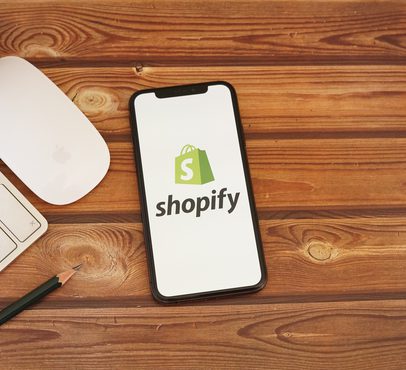Shopify’s popularity should give you a clear indication of its suitability for selling online, particularly for small businesses.
Launched in 2006, there are over 180,000 thousand e-commerce Shopify stores in the UK and 1,750,000 globally. It holds approximately 21% of the market share, just behind WooCommerce, its primary competitor. Other popular store builders you may also have heard of include Wix, Square and Squarespace.
But is Shopify for you?
In this blog...
Shopify for smaller brands & businesses: an overview
Shopify’s entire mission is to help you create an online store. As a hosted platform geared towards simplified, fast setup, it’s great for smaller or start-up brands looking to get a website off the ground and start selling online quickly.
It’s a turnkey solution — you can pick a theme and create a kitted-out, ready-to-go, easy-to-manage site without any coding experience.
The platform’s usability is one of its greatest assets; you’re guided through the store setup process with ease, with Shopify preempting almost everything you’ll require to get your e-commerce journey underway.
Running your store is simple: Shopify makes it easy to handle website building, content editing, payments, shipping and inventory management.
With an extensive marketplace for apps and extensions, Shopify allows you to quickly scale up if required. It also supports easy integration of other marketing activity, like social media, email, content and SMS.
However, Shopify’s superb user experience comes at a slight cost. Compared to Wix and Squarespace, it’s not the cheapest. Costs can add up for themes, features and custom solutions — Shopify also charges a small rate per transaction (more on this later).
Monthly costs start at £25 per month, but can try a free trial. There’s also a discount available when you start your store — £1 per month for the first three months.
“Launched in 2006, there are over 180,000 thousand e-commerce Shopify stores in the UK. It holds approximately 21% market share.”
Despite its suitability for startups and SMEs, Shopify’s popularity encompasses enterprise-level , multinational brands like Gymshark, Penguin Books and Tesla. The platform works well for store owners with large, complex inventories.
Shopify’s features for small businesses
Products and inventory
Even the Basic pricing plan offers unlimited product listings, unlike some other platforms that require add-ons.
It’s simple to navigate and manage your inventories and do product admin; Shopify offers oversell warnings and sales from different channels can be brought into one place. For one-product or one-service offerings, however, Shopify might be slightly overkill.
The platform also offers point-of-sale integration: if you operate a bricks-and-mortar store, you can keep your inventory levels in sync.
Checkout
Some online store builders offer rigid checkouts. Shopify’s, however, are very customisable: you can change fonts, logos and styles to match your brand.
One big plus point to Shopify is that it is so popular and your customers will likely already be subconsciously familiar with it — good news for facilitating that conversion.
Payment options
A number of payment providers are accepted: PayPal, Stripe, Apple Pay, Amazon Pay, Shopify Payments and many more. This makes it simple and familiar for users to pay for their basket. Third-party providers can incur a fee, though — more on that a little later.
Marketing
Shopify facilitates behavioural email marketing, paid media and social media; you can sell through Facebook, Facebook Messenger and Instagram, for example. It offers abandoned cart recovery and a number of other sales-driving automations.
By allowing you to edit title tags, meta descriptions, H1s and page copy, it’s also simple to optimise your website for search engines. You can also create a blog for your online store, which is great for content marketing.
Website design and content management
Shopify offers over 120 themes to choose from — 11 of these are free. This allows you to build a responsive, mobile-friendly website that looks the part.
It’s also simple to create, edit and delete pages on your website without any coding experience whatsoever through a clean, clear user interface.
Apps
In Shopify’s leading catalogue of apps and extensions, you can choose from a selection of free and paid add-ons to boost the offering and functionality of your site.
It’s worth noting that similar and free options for some of the paid apps can be found by performing a quick search. Most plugins on Shopify can be added easily with the touch of a button, helping to keep its record as the simple e-commerce site-builder.
International selling
If you’re exporting, then Shopify can translate the checkout and other essential system wording into a foreign language. This is great as people are typically more comfortable spending money at checkouts that are in their native language.
Analytics
Shopify is fantastic at helping you to learn more about your website’s performance and your customers’ behaviour.
Through the uncomplicated user interface of your Shopify Admin dashboard, you can easily get a snapshot of your website’s performance: how many sessions you’re getting, which marketing channels are driving sales and who’s abandoned their basket.
All valuable insights for refining your marketing strategy.
Security
Shopify is a hosted platform, with all stores maintained under a secure network. There’s nothing to worry about when it comes to server maintenance, software upgrades, payment fraud or SSL certificates.
Needless to say, Shopify takes the security of customer and card data extremely seriously, regularly testing networks and maintaining an information security policy with strong access control measures.
In the UK, Shopify has ID Secure to verify credit card purchases — this is two-factor authentication for confirming the cardholder’s identity. This means that the onus is on the card issuer for any fraudulent activity, not the merchant.
Support
Regardless of the plan you choose, Shopify advertises that support is available 24/7 over live chat, phone and email. Some users have reported that the level of service provided can sometimes be rather patchy, however.
Accounting tools
From the invoice generator to automatic tax calculations, Shopify’s excellent accounting functionality shows that they’re aware of all the difficulties and pain points of running a small business.
Shopify themes explained
The theme refers to the look and feel of your site — colours, fonts, layout, and features.
Currently, Shopify has 177 themes to choose from — 12 are free and 165 are paid. Costs range from $140-$400 (£110-£310). This might seem quite austere compared to competitors like Wix, who boast over 500 free themes.
Despite this, Shopify’s free themes are well-designed and attractive — they will certainly do a job for getting your small business’ site off the ground. Paid-for themes offer a range of options, features and customisations that will make your store look more unique.
No coding is required with Shopify themes and you can go on to change the palette, add pages and edit content, so a theme doesn’t mean your site has to look like anyone else’s.
Themes can be changed easily and your navigation buttons or products will be reconfigured, but note that non-product imagery and self-coded elements may need to be revisited.
Importantly, all Shopify themes are mobile ready. Considering 60% say they will not recommend a business that has a badly designed mobile site, this is great news indeed.
“46% of people say they would not purchase from a brand again if they had an interruptive mobile experience.”
Shopify pricing in the UK
Shopify offers a fairly clear tiered pricing structure. Usually, the Basic tier will be enough for small and medium-sized businesses — it offers unlimited products, standard analytics and two accounts.
The amount of user accounts increases as you go up the pricing tiers, with a slight reduction in fees per transaction. You also get more sophisticated analytics and can integrate with in-store activity.
Basic | Shopify | Advanced |
£25 per month | £65 per month | £344 per month |
|
|
|
If you’re umming and ahhing between tiers, Shopify offers a free trial and a £1 per month discount for the first three months. If you pay for your plan in one go for the year, you save 25%.
Shopify also offer some other, more niche plans:
Starter (£5 p/m): This is an easy, no-code setup that’s ready in minutes. It works very small-time operations, including selling over social media and messaging apps.
Retail (£69 p/m): Geared towards in-person selling with advanced staff, inventory, and loyalty features.
Shopify Plus ($2k USD+ p/m): Your enterprise-level plan for large, high-growth businesses.
How much does Shopify take per sale?
Every time you make a sale, you will pay a Shopify transaction fee depending on the level of plan you have (2% + 25p on Basic, 1.7% + 25p on Shopify, 1.5% + 25p on Advanced). So, the more expensive your monthly plan, the lower the fee per sale.
If you use Shopify Payments for all your sales, that’s all you’ll have to pay. However, if you’re directing users to a third-party payment provider, then you’ll have to pay an additional ‘third-party transaction fee’. Again, this is on a sliding scale. For Basic, it’s 2%, for Shopify it’s 1% and for Advanced it’s 0.5%.
To add to the confusion, note that some third-party payment providers are excluded!
“Third-party transaction fees apply on all third-party and alternate payment gateways even if Shopify Payments is activated. However, if you have Shopify Payments activated, then PayPal and manual payments are excluded from third-party transaction fees.”
All-in-all, we’re big fans of Shopify, particularly for smaller-sized businesses. It guides you through the early stages of your brand’s e-commerce journey and is fully kitted out and scalable, supporting your business as you grow.
Whilst it’s not the cheapest, many owners find it to still be excellent value. Shopify’s usability, sales features, functionality, support and design flexibility are top-drawer. No store builder is perfect, but Shopify comes as close as any.
Extreme: Shopify Partners at your service…
We have years of experience developing and marketing Shopify e-commerce stores for brands of all shapes and sizes — take a look at a few of our case studies!
If you think our talented team might be able to help you succeed on Shopify, don’t hesitate to drop us a message.
Starting a Shopify journey?
Get in touch todayPost by

Johnny bridges our content and SEO teams, creating and managing strategies that elevate clients' organic search visibility.
Project



